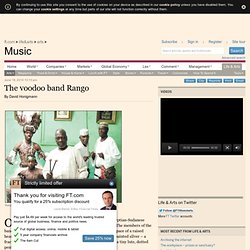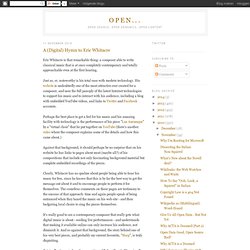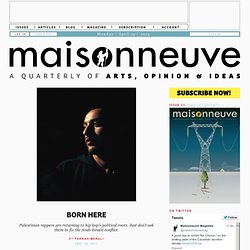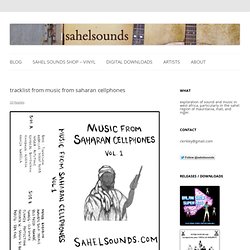

Theloniousmonk. Theo Parrish to collaborate with Tony Allen live tonight. Rubén Blades: Cantares del Subdesarrollo. Panamanian artist Ruben Blades was honored with a Grammy Award for Best Singer-Songwriter Album of the Year for his album titled Cantares del subdesarrollo [Songs of Underdevelopment].

[Also see previous post Ruben Blades releases new CD after 6-year absence.] The album, released in August last year, marked the return of the salsa icon after a five year absence from the world of entertainment. According to Blades, Cantares del subdesarrollo is spiritually dedicated to the people of Puerto Rico, especially to “el brujo de Borinquen, the great Ismael Rivera; to the great Tite Curet Alonso; and the great Ray Barretto, representing all my dear friends of the brega [roughly translated as daily endeavors] and musical discussion through these past 40 years.”
Musically, he says, he dedicates the album to Cuba, “for its original contributions to the development of urban music around the world.” For full reviews, see and. Arts - The voodoo band Rango. On a hot night in Abu Dhabi a couple of months ago, the Egyptian-Sudanese voodoo band Rango were on stage at the Womad festival.

The members of the band sat in a semi-circle, facing inwards. Their drums were the pace of a raised heartbeat, their shakers – aerosol cans filled with pebbles and painted silver – a fraction of a beat behind. The metallic plink of the simsimiyya, a tiny lute, dotted pentatonic patterns into the music. Turbaned, bespectacled, Zainab Mansour rose to her feet to dance and sing. A (Digital) Hymn to Eric Whitacre. Eric Whitacre is that remarkable thing: a composer able to write classical music that is at once completely contemporary and totally approachable even at the first hearing.

Just as, er, noteworthy is his total ease with modern technology. His website is undoubtedly one of the most attractive ever created for a composer, and uses the full panoply of the latest Internet technologies to support his music and to interact with his audience, including a blog with embedded YouTube videos, and links to Twitter and Facebook accounts. Perhaps the best place to get a feel for his music and his amazing facility with technology is the performance of his piece "Lux Aurumque" by a "virtual choir" that he put together on YouTube (there's another video where the composer explains some of the details and how this came about.) Ethiopian Jazz Musicians Make Older Music New Again. During the second half of the 20th century, cosmopolitan Ethiopians were delighted to see jazz giant Duke Ellington receive their country's Medal of Honor from Emperor Haile Selassie.

At the same time, by contrast, a Berklee College of Music-trained Ethiopian jazz legend, Mulatu Astatke, who fused jazz and funk with his country's folk and Coptic Church melodies, was unknown in the United States. In the 1960s, as the tastes of American jazz fans shifted from bebop to avant-garde, Ethiopian musicians were establishing a tradition whose compositions are just reaching American ears. Why did it take so long for this riveting, emotionally charged music to arrive? Ethiopian musicians like Astatke, singer Alemayehu Eshete, and guitarist and arranger Girma Beyene have devoted their lives to blending Ethiopia's traditional five tones per octave, or pentatonic scale, with Western chords.
The Rite of Spring. The Rite of Spring (French: Le Sacre du printemps, Russian: «Весна священная», Vesna svyashchennaya) is a ballet and orchestral concert work by the Russian composer Igor Stravinsky.

It was written for the 1913 Paris season of Sergei Diaghilev's Ballets Russes company; the original choreography was by Vaslav Nijinsky, with stage designs and costumes by Nicholas Roerich. When first performed, at the Théâtre des Champs-Élysées on 29 May 1913, the avant-garde nature of the music and choreography caused a sensation and a near-riot in the audience. Although designed as a work for the stage, with specific passages accompanying characters and action, the music achieved equal if not greater recognition as a concert piece, and is widely considered to be one of the most influential musical works of the 20th century. Background[edit] Synopsis and structure[edit] Rumba Rules: The Politics of Dance Music in Mobutu’s Zaire (9780822341123): Bob W.White. Experiments in Map-Making. Previously, this blogger complained about popular maps of North Africa as it related to AQIM, particularly in English-speaking media.

Below are some rough, experimental maps that attempt to show some of the priorities discussed last week’s post on some of the politics between the various actors in the Maghreb-Sahel region. Nothing here is perfectly depicted or with total accuracy, but they are a start toward … something. [UPDATE: Another map, after the jump.] 1. In the first map represents the priorities discussed in the posts referenced above. 2. 3. 4. 5. Like this: Like Loading... Born Here. Tamer Nafar of DAM performing in New York City.

Photograph by Thomas Anomalous. In Jesus' hometown there's an underground hip hop studio. Isle of Tune. Stjepan Hauser and Luka Sulic - Smooth Criminal. Tracklist from music from saharan cellphones « sahelsounds. This little cassette of music collected from cellphones has been in internet circulation lately (update — and the Guardian UK).

Pitchfork did a nice write-up on the phenomena of “musical scarcity”, Rupture at Mudd Up! Has given it some blog/radio play, and Portland’s own Gulls put together this remix of one of the tracks: Niger Autotune (Emsitka) — Gulls Edit Just to clarify, the music was not collected from “discarded” or “abandoned” cellular phones as has been reported.
It’s sort of funny, the notion that one could find memory cards or cellphones lying around in the trash. The somewhat ambiguous tracklist was a result of ID3 tags and guesswork. Side A: 01 – Group Anmattaf – Tinariwen (Tamaransett, Algeria) 02 – Hasso Akotey – Amidinine (Niger – myspace) 03 – Mdou Moctar – Tahoultine (Niger/Nigeria) 04 – Koudede – Souveniram (Niger – myspace) 05 – Hamdawa – Salaouat Nabina (Meknes, Morocco – awesometapes) 06 – Cheb Hamza and Cheba Wasila (Morocco) side B: Trinidadian Pannist Len “Boogsie” Sharpe. World-renowned pannist Len “Boogsie” Sharpe recently spoke to BBC Caribbean when he was in London.

Daily Dose Pick: Tinashé. A childhood spent in his native Zimbabwe informs the uplifting, intensely personal music of London-based singer/songwriter Tinashé and his debut album, Saved.

Playing modern pop with nods to Arctic Monkeys, Bloc Party, Vampire Weekend, and his original hero, Michael Jackson, the ebullient young artist tempers his guitar-driven tracks with traditional African influences and instrumentation. From the album’s transcendent title track to the longing “Good Times,” it’s a record full of hope, promise, and fantastic tunes. Monophtalmie - Histoire de la musique visualisation ici &... African and Afro-Caribbean Musicians Gaining Foothold in U.S. The cult of Michael Jackson in Japan, jazz quartets in Sweden, and rappers from Russia to the Gaza Strip. Black artists from the United States shape the music the rest of the world listens to and makes.
But black musicians from other parts of the world, especially Africa, still have a hard time breaking out of their niches and into our broader culture and playlists. African and Afro-Caribbean music have sent some shoots through the American scene. Nightclubs pulse to dancehall and reggaeton. The Broadway musical Fela! 'The Ninth': The politics and history that shaped Beethoven's last symphony. 'The Ninth: Beethoven and the World in 1824' by Harvey Sachs Random House, 213 pp., $26.